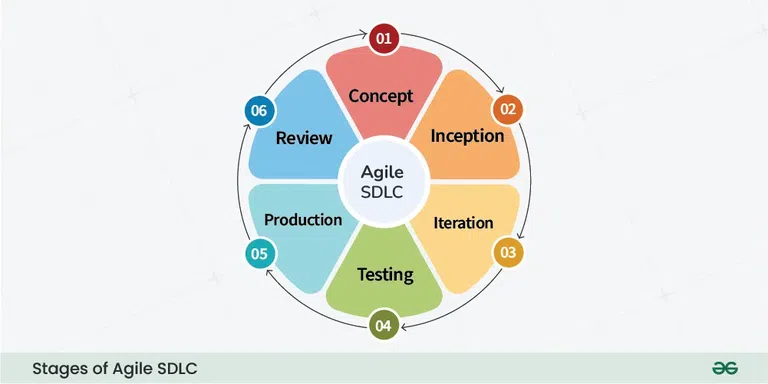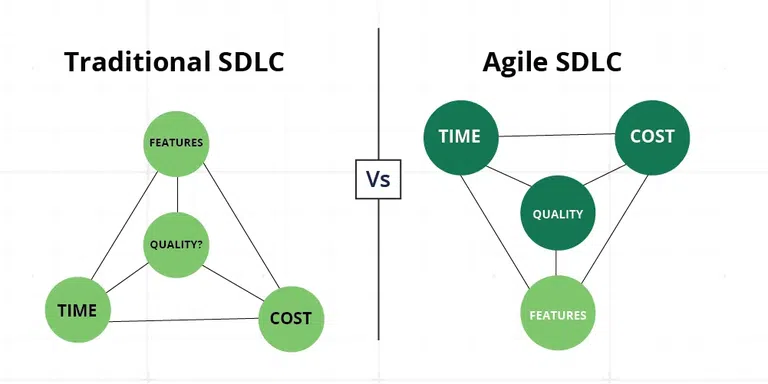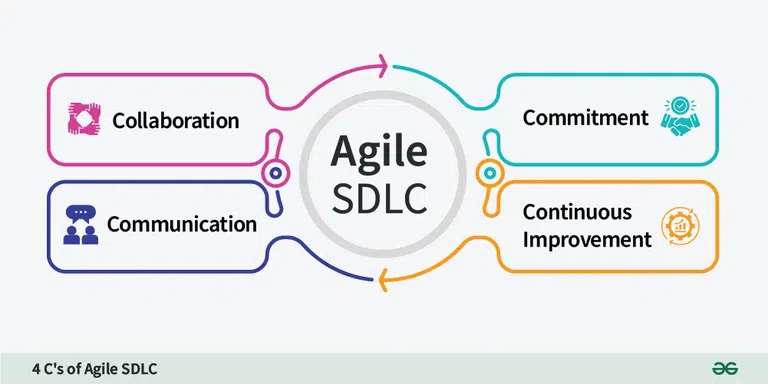Stages of the Agile SDLC (Software Development Lifecycle)
Last Updated :
23 Jan, 2024
Agile SDLC teams interact regularly through face-to-face meetings that promote problem-solving and communication. Teams can develop high-quality software that directly connects with customers by continuously reviewing and making adjustments because of continuous feedback loops. This iteration includes planning, carrying out, and reviewing each iteration to enable the product to adapt to changing market trends and customer needs. Agile flexibility enables development teams to respond swiftly to shifting objectives, resulting in software development that is more rapid and customer-focused.

Stages of the Agile SDLC
Scrum is an Agile Methodology Framework that offers a structured way to implement agile practices. Scrum provides a set of principles & best practices for managing large large-scale projects. Scrum breaks down work into smaller chunks called sprints. Each sprint typically lasts between two & four weeks. Each sprint involves planning, executing, daily face-to-face meetings, review & back & forth to continually improve your product & process. Scrum also includes role-specific roles such as product owner & scrum master as well as the development team each of which has its own set of duties to ensure transparency, cooperation & efficient delivery.
Agile is a broad methodology that includes different approaches to software development. Scrum is a particular implementation framework within agile that allows teams to work in a structured way & deliver value in the form of iterations. Agile & scrum both emphasize flexibility, customer engagement & iteration but there are subtle differences in how they work & how they are used.
|
Iterative developement
|
Framework within Agile
|
|
Values responding to change
|
Specific set of roles, events & atteacts
|
|
Flexible & attractive
|
Organized in spints
|
|
Focuses on customer collaboration
|
Scrum masters facilitates the process
|
|
Continuous improvement
|
Product owner & developement team these are the roles
|
|
Emphasizing working software
|
Product backlog, sprint backlog & increament
|
Stages of Agile SDLC (Software Development Life Cycle):
Stage 1: Concept
Stakeholders and product owners work together to establish the project’s goals and scope at the start of the Agile SDLC (Software development life cycle). To determine the project’s feasibility, they look at requirements, expected expenses, and anticipated completion dates.
Stage 2: Inception
The inception phase is the second of the Agile SDLC (Software development life cycle’s) six phases. The founder assigns positions, chooses the right team members, and provides development with the resources it needs throughout this stage.
It is crucial to create a plan and specify the core set of techniques and templates that will be applied to all future development work before starting the development phase. There are two parts to this planning phase, which is often referred to as the inception phase.
Stage 3: Iteration
UI/UX designers and developers must work closely together during this phase, which is usually the longest, to make sure that all business needs and feedback are implemented into the code. In order to finish the product backlog, the team goes through development iterations throughout this phase.
The agile methodology’s iteration (or development) phase is essential because it allows the team to produce a product with the fewest features possible, with more functionality added later. It’s time to finish the iteration, create technical documentation, and carry out quality assurance procedures when the development phase is over.

Stages of Agile SDLC
Stage 4: Testing
The team is pleased with the first iteration of the software, and development proceeded without a hitch. The app must pass a quality assurance review before being released. To make sure the app is fully working, the Agile team tests it by:
- Verifying the cleanness of the code
- Fixing flaws and mistakes
- Conducting trial runs
Stage 5: Production
The Agile team releases the program to an on-premises server or the cloud when it’s ready for public release.
The product is live and available to clients as soon as it is launched. In the Agile SDLC, deployment is typically the most joyful phase: you made it! Give yourself a pat on the back now, but you still have one step left.
Stage 6: Review:
At this stage of an Agile SDLC (software development life cycle), maintaining long-term success becomes more important than executing a successful launch. Following the product’s successful debut, customers often offer suggestions for future features, interact with current upgrades, or provide feedback.
The responsibility now shifts to the development and operations teams in addition to the stakeholders to continuously support the application to guarantee its smooth functioning.
Each time a new feature is released, it needs to be tested alongside all existing features. There’s a risk that newly written code will clash with previously written code with every compilation, breaking features and functionalities that are already in place. New features should improve the user experience, not make it worse.
Agile SDLC vs Traditional SDLC:

Agile SDLC vs Traditional SDLC
|
Iterative developement
|
Sequential developement
|
|
Adaptive to change
|
Fixed requirements
|
|
Customer collaboration
|
Customer involvement at the begining & the end.
|
|
Emphasis on working software
|
Comprehensive documentation
|
|
Flexibility in project scope
|
Fixed project scope
|
|
Quick & frequent feedback loops
|
Feedback at specific project stages
|
|
Cross functional teams
|
Speacialized teams
|
|
Continous integration & delivery
|
Phase developement & delivery
|
|
Embraces change thorughout project lifecycle
|
Change control processes in place
|
Benefits of Agile SDLC:
- Customer Satisfaction: Agile methods focus on customer engagement & feedback, making sure the product delivered is in line with the customer needs & expectations.
- Flexibility & Adaptibility: Agile enables teams to adapt to changes as they occur throughout the development lifecycle allowing them to adjust to changing needs & market conditions.
- Improved Quality: In agile continuous testing & integration help troubleshoot fix bottlenecks early in the product lifecycle resulting in better products.
- Enhances Transperancy: Meeting on a daily basis keeps the team & stakeholders on the same page, promoting communication & harmonization.
- Risk Mitigation: With multiple iterations & multiple deliveries, teams are able to identify & mitigate risks early, minimizing the risk of major project failures.
- Efficient Resource Utilization: Agile methodologies make it easier to allocate resources by concentrating on delivering high value features & making changes to plans based on user feedback increasing value while reducing costs.
Limitations of Agile SDLC:
- Scope Creep: Agile adaptability can sometimes result in scope creep where constant changes & add ons to requirements can add more time to exceed the original scope.
- Dependency: Agile relies heavily on the team working together. Communication gaps within the team can impede progress & negatively affect the project success.
- Resource Intensive: The constant iteration, meetings & feedback takes up a lot of the team time & attention which can affect productivity in other areas.
- Lack of Documentation: Agile puts working software first which can result in a lack of documentation which can make it hard for new employees to get started for existing employees to refer to.
4 C’s of Agile SDLC:
- Collaboration: Agile methodologies prioritize collaboration among team members & stakeholder engagement. It involves ongoing dialogue, brainstorming & decision making with the aim of achieving shared objectives.
- Communication: Clear and effective communication in agile is key. Teams need to be able to communicate clearly & effectively. They need to have open channels to share information, thoughts & worries. Continuous communication is supported by daily stand ups & sprint planning meetings as well as regular reviews & retrospectives. Transparent & regular communication between team members, stakeholders & customers ensures consistency & allows for rapid response to changes.
- Commitment: Agile teams are committed to meeting each iteration goals & objectives. Commitment means team members working together to deliver the scope & features agreed upon within the defined timeframe. It also means quality, making sure the delivered product meets expected standards & meets customer needs.
- Continuous Improvement: Agile fosters a culture of continuous improvement. Teams regularly review their processes, workflows & results through back and forth meetings to identify areas of improvement. By continually looking for ways to increase efficiency, effectiveness, quality, agile teams evolve & adapt striving for incremental improvements in working practices & end products.

4 C’s of Agile SDLC
Conclusion: Stages of the Agile SDLC (Software Development Lifecycle)
The Agile SDLC is a strong framework that helps teams to produce high-quality software, adapt to changing needs, and improve teamwork all the way through the development process. Agile methodologies provide a flexible and adaptive approach to software development, improving your chances of project success in today’s rapid and constantly changing business environment. They do this by accepting iterative development, continuous feedback, and a commitment to continuous improvement.
FAQ’s of Stages of the Agile SDLC (Software Development LifeCycle):
What is Agile SDLC?
Agile SDLC is an iterative and flexible approach to software development that prioritizes collaboration, adaptability, and customer satisfaction. It comprises a set of principles and practices designed to deliver high-quality software incrementally.
What are the key stages of the Agile SDLC?
The key stages include:
- Planning: Define project scope, prioritize features, and create a roadmap.
- Design: Develop user stories, wireframes, and architectural design.
- Development: Iterative coding and testing of software features.
- Testing: Continuous testing, including unit, integration, and user acceptance testing.
- Deployment: Incremental release and deployment of software.
- Monitoring and Feedback: Collect user feedback and monitor system performance for continuous improvement.
How is Agile different from traditional SDLC models?
Agile emphasizes flexibility, collaboration, and customer feedback. It delivers software in small, incremental releases, allowing for quick adaptations to changing requirements. Traditional models, like Waterfall, follow a sequential approach with less flexibility for changes once the development has started.
The Product Owner is responsible for defining and prioritizing the product backlog, representing the customer’s interests, and ensuring that the development team delivers value-aligned features.
How does Agile handle changing requirements?
Agile embraces changing requirements by accommodating them in the backlog. The iterative nature of Agile allows teams to adapt quickly to evolving needs, incorporating changes in each iteration.
Share your thoughts in the comments
Please Login to comment...